RECENT COMMENTS
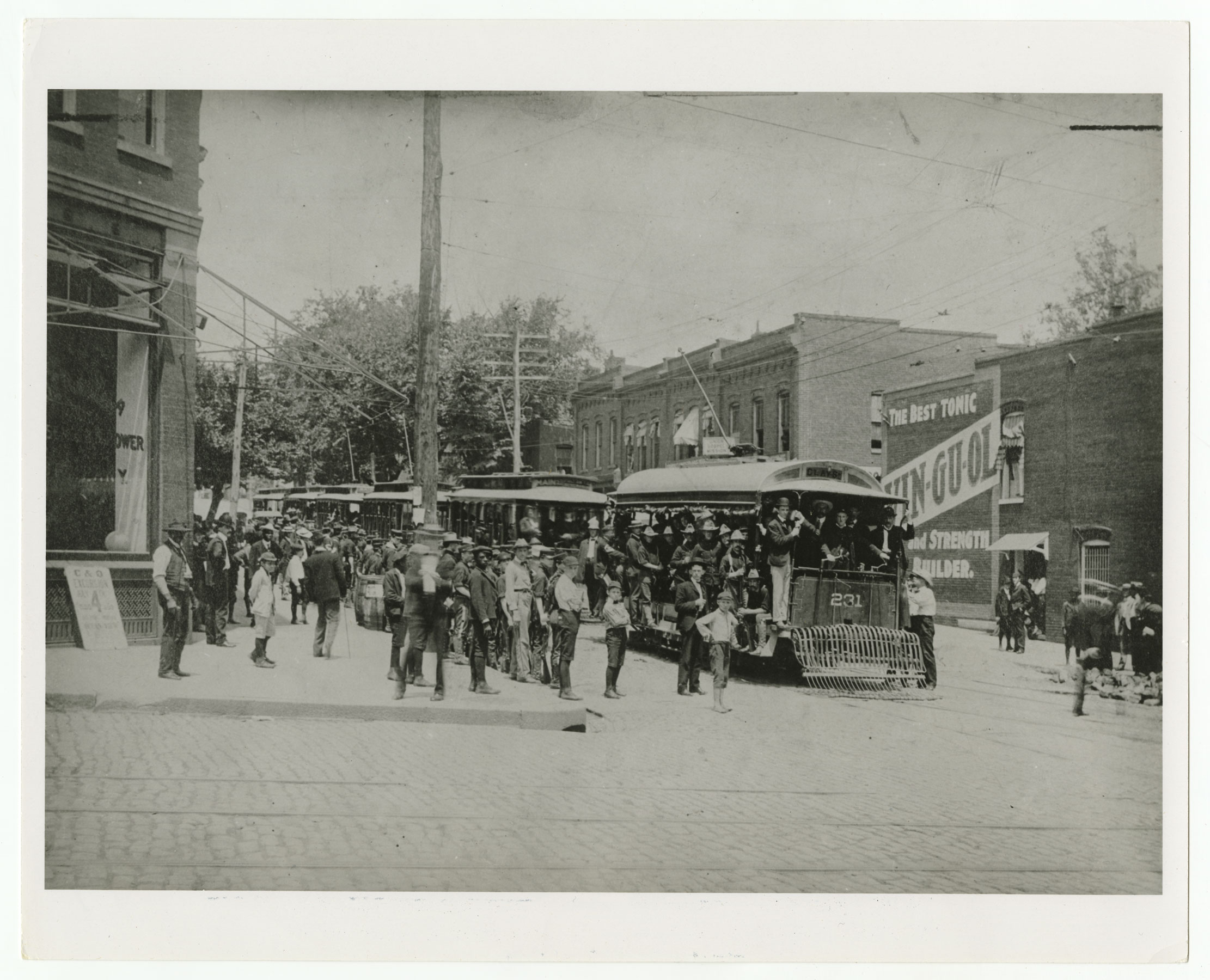
The Richmond Trolley Strike of 1903
During the summer of 1903, Richmond was under nearly martial law when a two-month long streetcar strike broke out in late June.
Between 1895 and 1929, almost every major city in the United States experienced a streetcar strike. The Richmond strike followed on the heels of streetcar strikes in Providence, Rhode Island, in 1902 and Waterbury, Connecticut, earlier in 1903. The San Francisco Streetcar Strike of 1907 was among the most violent, with thirty-one people killed and over 1,000 injured. A 1910 labor strike by trolley workers of the Philadelphia Rapid Transit Company grew to a city-wide riot and general strike. The Richmond strike was by the street railway employees of Richmond, Manchester, and Petersburg lines, all run by the Virginia Passenger and Power Company.
The striking employees were asking for a raise of three and half cents per hour, or if denied, to submit the matter to arbitration. The motormen were at that time paid between 15 to 18 1/2 cents per hour; the requested raise would be a 14-20% increase in pay. General Manager of the company, S.W.Huff, declined both options in a letter dated June 15, 1903. The employees had strong support in the community – to the point that militia later called in from around the state at first complained that local police officers were intervening on behalf of strikers.
All but 7 of the 650 present members of the Local Union No.152 Amalgamated Association of Street Railway Employees voted early on June 17 to strike. No trolley cars ran that day.
That evening 23 special policemen were sworn in by the Police Board and Chief Howard. The Times-Dispatch estimated that 200 strike breakers had already arrived in town, with cots being available in the trolley barns for the breakers. The strikers were taking shifts picketing at the train station to deter the arrival of others.
— ∮∮∮ —
— ∮∮∮ —
Using strike breakers from Pennsylvania, the company was able to operate four or five cars on the Main Street line from Robinson Street to Ninth Street for almost four hours that Thursday, June 18th. A street cleaner was arrested at 7th and Main for cursing at the strike breakers, precipitating “an ugly situation that approximated a mob” that “at one time threatened violence”. There were reports that some cars were pelted with “mud, eggs, and filth”, with one lady being struck on the arm by a mud ball thrown by someone in a crowd of women and children. The company president, Sitterding, was hit by an egg.
— ∮∮∮ —
— ∮∮∮ —
On the 3rd day of the strike, cars were run from the Reservoir to Fulton with little incident. Strike breakers were “jeered in the suburbs”, and one car was stoned in Fulton. Six more special police were added to the force, and the police worked to keep crowds from forming. There were a few arrests, for “using language calculated to promote disorder.” The trolleys stopped running at dark, as the police were unable to provide adequate protection.
On Monday, June 22nd, the 6th day of strike, the company moved to resume service on Broad Street. Later that evening, the situation began to heat up. Between 6 and 7PM, a crowd gathered at 18th and Broad threw “stones, potatoes, and other missiles” at the cars turing from Broad. The police were unable to disperse the crowd.
A band of about 40 young men were seen in the night gathering “bricks, stones, rocks, huge boxes, and other impediments” to prevent the running of the cars in that stretch the next morning. The curve running around Lester Street in Fulton was thoroughly blocked. An attempt was made to cut the pole at Denny and Second supporting the electric wires, and someone tried to burn Rocketts bridge. Cars were attacked in the West End of the city “by mobs”, in one instance forcing a strike-breaking motorman to flee to avoid injury.
— ∮∮∮ —
— ∮∮∮ —
On June 23rd there was a “riotous” scene at 29th and P Streets, in which 2 company men were hurt and trolley cars were “roughly used”. At least 50 company men were sent to the hospital after being hit by thrown objects after a riot at Main and Vine Streets during which a trolley car was derailed. In response to the escalating violence, Governor Montague called out 16 companies of militia: the Richmond Blues Battalion, the Richmond Howitzers, and other groups from Danville, Farmville, Charlottesville, Staunton, Lynchburg, Alexandria, and Roanoke to protect the employees and property of the railway company. Sharpshooters were given permission to fire at anyone throwing objects at trolley cars.
— ∮∮∮ —
— ∮∮∮ —
On June 24th, railway company guards fired into a crowd of between 500-1000 gathered that evening at Lombardy and Main, wounding six people. After a day of having “missiles hurled at the cars and obstructions placed on the track”, the trolleys were recalled to the barns under cover of a Gatling gun. Richmond Mayor Richard Taylor asked women and children to remain at home.
The end of June followed a similar pattern: the cars ran by day, guarded by militia men, and violence broke out at night. Two soldiers were shot near Walnut Street. Warning volleys were fired after rocks were thrown at trolleys near 22nd and Church Hill Avenue. Sixteen-year-old Lester Wilcox was shot in the hip and hand by militia soldiers after an incident on Lester Street after yelling “scab” at a passing street car. The soldier who did the shooting was never identified. Sticks of dynamite were found concealed in the grass by Williamsburg Road.
By June 30, the company was describing the strike as broken.
On July 4, Luther Taylor was shot and killed by a soldier while attempting to escape arrest at Cowardin Avenue and Hull Street. His horse was also shot and killed at that time.
On July 16, two cars were fired upon on the Oakwood line, and an attempt was made to wreck a car near Barton Heights.
By mid-July the militia were being sent home and some of the special police were being withdrawn from the streets.
— ∮∮∮ —
— ∮∮∮ —
By the end of July, all lines were running back on regular schedule, manned by replacement workers.
William Fox was arrested for dynamiting Car No. 118 at Broad and Lombardy on July 31. There were no injuries.
August’s early headlines turned to the trial of 5 men arrested during the Fulton street car riot on July 15. A.B.Jordan, John Lammie, E.Kane, and John Kane were charged with riotous conduct and throwing and shooting at trolley cars. The 12 members of the jury were proudly identified by the Times-Dispatch as “twelve businessmen” and “well known citizens”.
The defense said that the riotous action was sparked by Detectives Newman and Hanks, two employees of the rail company, to create sympathy for the company and break the strike. This view was attested to under oath by Lt.Ranklin of Colonel Anderson’s staff. Other witnesses for the defense admitted that Power and Passenger officers knew that the riot was to take place, and arranged for the car to be at the particular place at a certain time, and that it had been arranged for the lights to go out. The conductor of the specific car denied allegations that he received $100 to make the Fulton run that fateful evening. The alleged Fulton rioters were acquitted on August 11.
On August 24, the men of Local Union No.152 Amalgamated Association of Street Railway Employees voted unanimously to end the strike which had been nominally over several weeks.
The image at the top is from the Virginia Historical Society. The map is from Carlton McKenney’s Rails in Richmond. All others are from The Times Dispatch issues available at the Library of Congress’ Chronicling America.






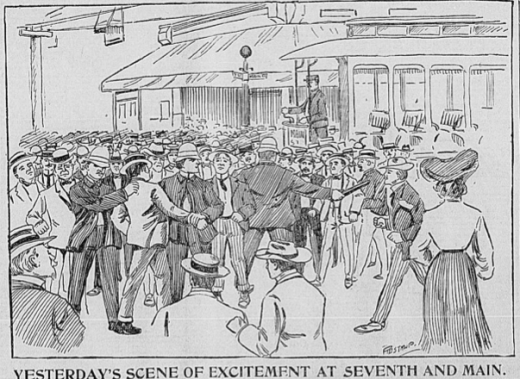
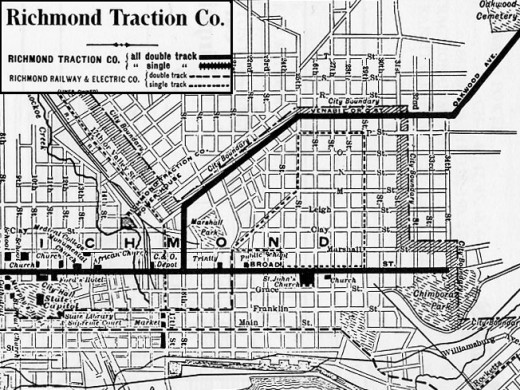
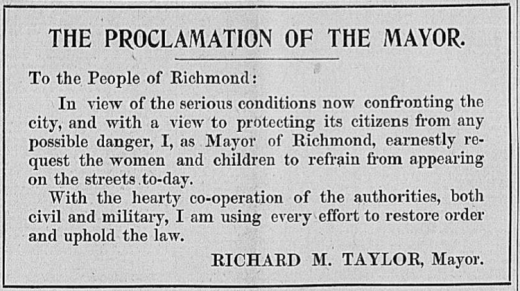
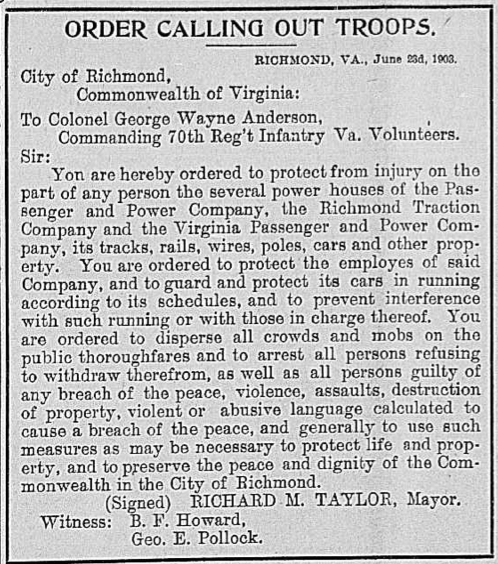
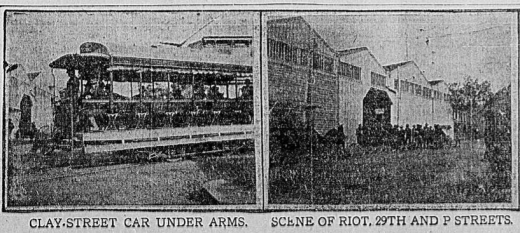

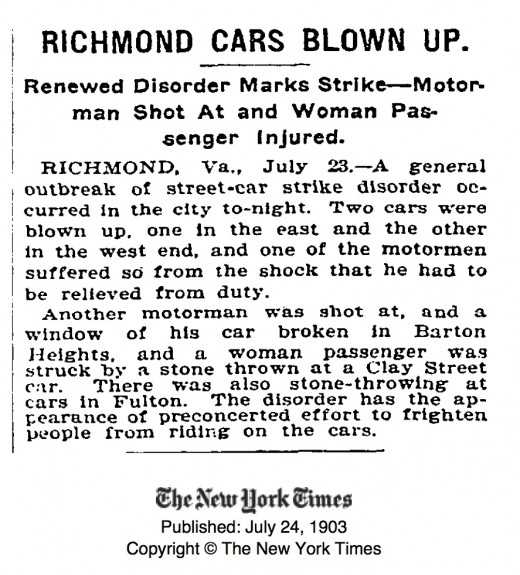
That is some amazing history, beautifully put together. Thank you for posting it.
http://www.oregonhill.net/2009/07/13/anniversary-of-streetcar-bombing/
Where was Church Hill Avenue?
In 1882, the great divide at the southern edge of Union Hill was filled and graded to create Church Hill Avenue (renamed Jefferson Avenue in 1905). There is an 1897 map here showing “New Churchill Avenue”.
Very interesting read.
I really enjoyed this one, John. Would love to see double track street cars coming up Venable today.
Not directly tied to Dr Tancil’s boycott work but interesting context for the events of that same era